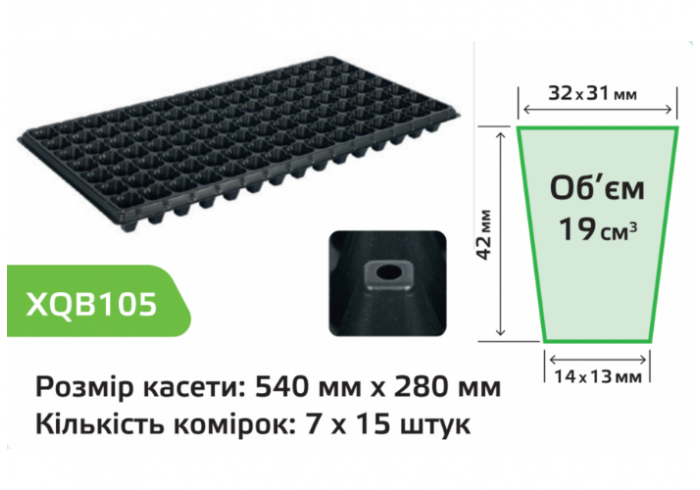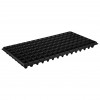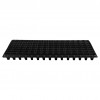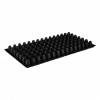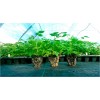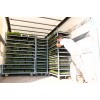Dutch Standard XQB105
- Cell volume : 19 cub. cm
- Number of cells: 105
- Size of the cassette : 540х280 mm
- Size of the cell : 31х32 х 42 х 13х14 mm
Dutch Standard XQB105
The cassettes we offer are made of high-quality polystyrene. Unlike cheap PVC (polyvinyl chloride) cassettes presented on the Ukrainian market, polystyrene does not contain poisonous substances, in particular chlorine, which can cause serious harm to human health. A wide range of cassettes offered by us will be able to satisfy any request.
The reliable design guarantees the use of cassettes for up to several seasons, which significantly reduces the cost of seedlings. Thanks to reinforced sides, cassettes for seedlings can be moved without damaging the plants.
In addition, we offer pallets to maintain moisture in the cassettes. Cassettes with pallets can be placed on the windowsill, which is very convenient when growing seedlings at home, pallets are indispensable when it is necessary to transport seedlings to the place of planting in the field without loss.
The advantage of growing seedlings in cassettes:- the same growth conditions for all plants;
- the root system is not damaged during transplanting;
- good division of the root system of individual plants;
- saving seeds and substrate, as well as reducing transport costs;
- the possibility of receiving a large batch of plants;
- saving space in the greenhouse (plant density from 200 to 2000 per 1 square meter);
- reduction of labor intensity of production;
- effective protection of plants from diseases transferred from the soil;
- possibility of repeated use of cassettes;
- ease of disinfection after each processing cycle;
- the possibility of breeding from seedlings plants that do not tolerate transplanting well (for example, Napa cabbage).
| Crop | XQ21 | XQA32 | XQB50 | XTB50 | XS50 | XQB72 | XT72 | XS72 | XQB105 | XQB128 | XS288A | Q6 | ||
Tomato |
 |
 |
 |
 |
 |
 |
 |
 |
 |
 |
 |
 |
 |
Depending on the age of the seedlings and the time of planting in open ground, you can use one of the suggested cassettes. Seedlings should be transplanted carefully, with a pinch of soil, without damaging the roots. |
|---|---|---|---|---|---|---|---|---|---|---|---|---|---|---|
Cucumber |
 |
 |
 |
 |
 |
 |
 |
 |
 |
 |
 |
 |
 |
To create optimal conditions for plant development and reduce damage to the root system during transplanting, use cassettes with the maximum volume of cells, because cucumber does not tolerate the transplant process well. |
Early cabbage |
 |
 |
 |
 |
 |
 |
 |
 |
 |
 |
 |
 |
 |
To obtain early and high-quality crops, it is better to grow cabbage as seedlings, and sow the seeds around February - March. The optimal age of seedlings is 40-45 days. Seedlings must be hardened before planting, as the quality of the seedlings directly affects the final harvest. |
Medium cabbage |
 |
 |
 |
 |
 |
 |
 |
 |
 |
 |
 |
 |
 |
To obtain early and high-quality crops, it is better to grow cabbage as seedlings, and sow the seeds around February - March. The optimal age of seedlings is 40-45 days. Seedlings must be hardened before planting, as the quality of the seedlings directly affects the final harvest. |
Late cabbage |
 |
 |
 |
 |
 |
 |
 |
 |
 |
 |
 |
 |
 |
To obtain early and high-quality crops, it is better to grow cabbage as seedlings, and sow the seeds around February - March. The optimal age of seedlings is 40-45 days. Seedlings must be hardened before planting, as the quality of the seedlings directly affects the final harvest. |
Napa cabbage |
 |
 |
 |
 |
 |
 |
 |
 |
 |
 |
 |
 |
 |
To obtain early and high-quality crops, it is better to grow cabbage as seedlings, and sow the seeds around February - March. The optimal age of seedlings is 40-45 days. Seedlings must be hardened before planting, as the quality of the seedlings directly affects the final harvest. |
Cauliflower |
 |
 |
 |
 |
 |
 |
 |
 |
 |
 |
 |
 |
 |
Cauliflower seeds are sown 35-40 days before planting seedlings. The latter is watered regularly and moderately, preventing drying out, as this leads to the appearance of small heads. Feed and harden in the same way as white cabbage. |
Pepper |
 |
 |
 |
 |
 |
 |
 |
 |
 |
 |
 |
 |
 |
Seeds can be sown in one of the cassettes. 15-20 days after the emergence of seedlings (2-3 real leaves), plants must be transplanted into larger containers or to a permanent place. |
Eggplant |
 |
 |
 |
 |
 |
 |
 |
 |
 |
 |
 |
 |
 |
Eggplant is a crop that is not recommended to be sown immediately in larger cassettes, because the crops develop slowly, the root system cannot use the entire volume of the cell at once, and the soil can dry out at the edges. |
Celery |
 |
 |
 |
 |
 |
 |
 |
 |
 |
 |
 |
 |
 |
Celery has a peculiarity - small seeds, and it germinates slowly. Seedlings should be no more than 60 days old. The advantages of the cassette method are obtaining an early harvest and guaranteed achievement of the planned density of plant placement on the appropriate area. |
Zucchini melon watermelon |
 |
 |
 |
 |
 |
 |
 |
 |
 |
 |
 |
 |
 |
The whole cucurbit family does not tolerate transplanting well, it is better to choose immediately cassettes of a larger size and volume. The size of the cassette depends on the age of the seedlings and the planting period. |
Wild strawberry |
 |
 |
 |
 |
 |
 |
 |
 |
 |
 |
 |
 |
 |
Wild strawberry seedlings are planted in early spring or late autumn. The first rosettes, which have rudiments of roots, are separated from the mother bush and after 15-20 days you can grow strong seedlings. For growing, seedlings should be taken from pre-selected healthy varietal bushes no older than two years of age. |
Flowers |
 |
 |
 |
 |
 |
 |
 |
 |
 |
 |
 |
 |
 |
Flower seedlings are planted from October to the end of May. Seedlings of perennial flowers are planted in autumn, winter and early spring, and already in March you can start planting seedlings of annual flowers. |
Onion |
 |
 |
 |
 |
 |
 |
 |
 |
 |
 |
 |
 |
 |
Onion is a fairly cold-resistant crop. Crops are planted in open ground in the second decade of April - early May, depending on the region. The age of seedlings should be 40-50 days, for this you can use the indicated cassettes. |
| Specifications: | |
| Cell volume | 19 cub. cm |
| Number of cells | 105 |
| Size of the cassette | 540х280 mm |
| Size of the cell | 31х32 х 42 х 13х14 mm |



